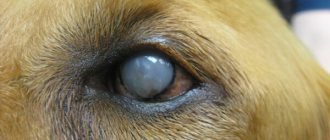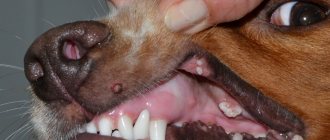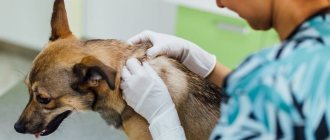Stye in a dog
The eyelid contains numerous glands that open at the edges (the sebaceous glands of the eyelashes - meibomian glands).
They produce an oily substance that protects the eyes from drying and rubbing of the eyelids, as well as from excess tear fluid and foreign bodies. Blockage of the ducts of these glands or their inflammation leads to swelling of the eyelids. A “red pocket” or “stye” forms on the eyelid.
Causes
When one of the pathogens (microorganism) penetrates the hair follicle or sebaceous gland, it begins to multiply intensively, which is why the disease can spread to nearby tissues and contribute to the formation of several styes.
Barley can be located not only outside, but also from inside the eyelid:
- External stye - this type of stye manifests itself in inflammation of the hair follicle or sebaceous gland, redness and increased inflammation appear on the outside of the dog’s eye, and a tumor appears. And after a while, pus may appear in the tumor.
- Internal stye – this type of stye in dogs appears on the inside of the eyelid. Inflammation of the meibomian gland lobule (fatty gland of the cartilaginous plate of the eyelid) occurs.
The reason for the appearance of barley on a dog's eye may be the entry into the sebaceous gland or hair follicle, microbes, fungus, as well as microscopic mites.
Factors contributing to the appearance of stye on the eye in dogs are:
- Staphylococcus aureus.
- Weakening of the body as a result of disease.
- Toxic-allergic conditions.
- Hypothermia.
- The presence of an uncorrected refractive error.
- Contact with small foreign bodies on the conjunctiva.
- Stress.
- A-hypovitaminosis.
- Unbalanced diet.
- Lack of eye care.
- Conjunctivitis.
Infection can also occur hematogenously. Styes begin with local redness, soreness and slight swelling in the area of the ciliary edge of the eyelid. After 2-4 days, a yellowish head forms at its top. On the 3-4th day from the beginning of the process, the abscess is opened and purulent contents and particles of necrotic tissue are released from it.
In other cases, either resorption of the infiltrate or its organization occurs. Sometimes, especially when squeezing out pus, barley can cause phlegmon of the orbit, thrombosis of the cavernous sinus, and meningitis.
How to help your pet
Treatment of barley in dogs is general and local. Sulfonamide drugs are prescribed internally.
Local treatment of barley involves the use of antibiotics in the form of eye ointments (hydrocortisone, tetracycline, maxitrol, erythromycin, 10% sodium sulfacyl) or Levomycetin drops.
Hydrocortisone should be applied directly to the inflammation itself, and tetracycline should be applied behind the lower eyelid. Be sure to smear both eyes, even if there is inflammation in only one.
Ointments are applied 5-6 times a day, in extreme cases - at least 3 times a day. Before using the ointment, the eyes should be rinsed with boiled water or a decoction of calendula or chamomile. These herbs have excellent antiseptic properties and will prevent inflammation from spreading further.
One of the most common means of controlling barley is dry heat. Boil the egg, peel, wrap in a clean scarf and apply to the inflamed area. Only this should be done only after opening the abscess. Otherwise, the process will only get worse. You can also use tea lotions and baked onions.
Barley can also be treated with ethyl alcohol 70 degrees. To do this, drop alcohol onto a cotton pad and apply it to the barley for a couple of minutes.
You can use albucid - instill 1-2 drops into each eye 4-6 times a day.
UHF and tube quartz are also used to treat barley in dogs.
Local treatment is carried out until the symptoms of inflammation disappear. In case of massive processes, the barley is opened in combination with general antibacterial treatment. For recurrent barley - autohemotherapy, vitamins, oral antibiotics.
Under no circumstances should you pierce the purulent cap and squeeze out the pus. This can cause infection to penetrate deep into the eye and cause more serious diseases such as meningitis or sepsis.
On average, barley should go away in a week. If this does not happen, then perhaps you are dealing with another type of blepharitis, which includes stye. Visit your veterinarian again to have him prescribe additional medications.
Source: https://VetPomosch.ru/sobaki/lechim-yachmen-u-sobaki/
Symptoms of stye
The pathology is easy to distinguish from other eye diseases.
Barley has characteristic symptoms:
- redness of the lower (upper) eyelid;
- swelling, especially well expressed in the interciliary space;
- the appearance of pain (the animal rubs its eyelids with its paw, whines);
- copious discharge in the corner of the eyes;
- the formation of a lump filled with exudate.
The pathological condition causes discomfort and pain to the animal. The pet needs immediate medical attention.
How to cure inflammation in a dog's eye?
Barley is an inflammation of the sebaceous gland or hair follicle of an eyelash; it is one of the types of a disease such as blepharitis. Its cause may be the entry of microbes or fungi into the sebaceous gland or hair follicle, as well as microscopic mites. There the pathogen begins to multiply and spread to nearby tissues. A still weak puppy can develop stye for a number of reasons:
- hypothermia,
- stress,
- lack of vitamins,
- unbalanced diet
- lack of eye care,
- conjunctivitis.
Barley can be located not only on the outside, but also on the inside of the eyelid. Symptoms of a stye are an inflamed swelling on the eye, the dog rubs it because it is in pain, and the eye also itches. But you can’t give it scratching, because the dog’s paws spread the infection into the already affected eye. After some time, a purulent head appears on the swelling, which soon opens.
After this, recovery from this inflammation begins. On average, this process lasts from a week to two. If it drags on, you should urgently seek help from a veterinarian so as not to miss a more serious disease.
Folk and medicines
- Styes in dogs are treated with hydrocortisone or tetracycline ointments. Hydrocortisone should be applied directly to the inflammation itself, and tetracycline should be applied behind the lower eyelid. Be sure to smear both eyes, even if there is inflammation in only one. Ointments are applied 5-6 times a day, in extreme cases - at least 3 times a day.
Before using the ointment, the eyes should be rinsed with boiled water or a decoction of calendula or chamomile. These herbs are famous antiseptics and will prevent inflammation from spreading further.
- You can also burn barley with alcohol. To do this, drop alcohol onto a cotton pad and apply it to the barley for a couple of minutes. This procedure must be repeated 2-3 times a day.
- Another common treatment for stye is dry heat. To do this, you need to boil an egg, peel it, wrap it in a clean scarf or napkin and apply it to the inflamed area on the eye. However, this should be done only after opening the abscess.
Otherwise, it may open not outside, but inside the eye. Under no circumstances should you pierce the purulent cap and squeeze out the pus. This can cause infection to penetrate deep into the eye and cause more serious diseases such as meningitis or sepsis.
Source: https://zivotnie.ru/kak-lechit-iachmen-na-glazy-y-sobaki/
Prevention
Like any other disease, it is better to prevent the appearance of barley than to deal with inflammatory processes later. To do this, you will need to review your dog's diet. It must be balanced. The animal absolutely needs vitamins and minerals. This diet helps strengthen the immune system. According to veterinarians, this is the main preventive measure. It is important to remember that the dog must be kept clean, walked with it a lot, regularly perform hygiene procedures and feed only high-quality food. In this case, the risk of barley will be minimized.
The dog has an inflammation in his eye
Often in pets, localized inflammation or styes occur at the edge of the eyelid. Dogs are also susceptible to this disease.
A stye occurs on a dog’s eye due to inflammation of the sebaceous gland or hair follicle. This leads to the formation of a tumor, which, if left untreated, fills with pus.
Subsequently, the abscess ruptures and there is a high probability of infection of nearby tissues.
Outwardly, it looks like a bump near a dog's eye. The animal becomes restless when such a neoplasm appears: barley causes pain to the animal and simply interferes. A stye on a dog’s eye can be located both on the outer and inner side of the eyelid.
Causes of the disease
Barley can form under the influence of various factors:
- Getting various types of contaminants into the eye: sand, dust, grass, wool.
- Violation of the rules for caring for the eyes of an animal.
- Decreased body resistance to infections as a result of previous illnesses.
- Hypothermia, stress or irregularities in your dog's diet.
- Allergic reaction or intoxication of the body.
- Conjunctivitis and infection in the eye tissue.
Symptoms and signs
- The early stage of the disease is characterized by swelling and hyperemia of the affected eyelid .
- The dog becomes restless and constantly rubs his inflamed eyelids with his paws, which further aggravates the problem.
- The animal behaves in fear , does not allow itself to be touched, and when the eyelid is touched, it becomes aggressive, tries to bite the owner, and there is noticeable pain.
- A more advanced stage is characterized by the formation of pus at the site of the lesion .
- The small lump increases in size and becomes similar to a large tumor.
When sick, a dog constantly rubs its eyes with its paws.
The transition from one stage to another takes several days - from two to four.
After this time, a spontaneous breakthrough of the abscess occurs or the opening does not occur at all and the tumor gradually disappears. However, this does not mean that the infection has gone away.
Treatment of dogs in hospital and at home
If a dog has stye in his eyes, treatment is usually not complicated and can be done at home. It consists of washing the eyes and applying compresses. Drops and ointments can be used as treatment.
The veterinarian may also prescribe tablets. In some cases, the doctor may surgically remove the stye or make a different diagnosis altogether.
When treating dogs, both the veterinarian and the pet's owners should wear gloves to protect themselves from possible infection during bites.
Sometimes dirt, sebum and dead skin cells clog your pet's hair follicles in the eyelid area, causing swelling and irritation of the skin. In other cases, the onset of the disease may be a bacterial infection.
Initial treatment for stye begins with gently rinsing the dog's eye to remove any eye irritants. Rinsing can be done with a clean sponge or piece of gauze.
Gentle heat helps the skin pores relax and open, making them easier to clean. After washing your eyes, you need to apply compresses to it several times a day, which will help get rid of the problem faster. As compresses, you can use bags of rice or sand, which are heated in the microwave before use.
When the source of the problem is bacteria, you should resort to medicinal ointments and medications. They are quite easy to use. Lift the animal's muzzle up, gently pull the eyelid forward and drip the medicine under it. Your veterinarian may prescribe tablets that can be easily given to your dog hidden in his food.
Depending on the severity of the condition, the doctor may prescribe the use of cortisone, a substance that reduces inflammation and swelling of the skin. Dog owners typically use these medications to treat older animals where styes are a persistent problem that other treatments no longer help.
In most cases, barley in a dog goes away on its own during treatment. However, if this does not happen and the stye is making it difficult for the dog to see, the vet may decide to remove it.
Barley is removed using a regular syringe with a sterilized needle or scalpel.
Before the procedure, the animal is usually calmed with sedatives, after which the dog’s eye area is cleaned with a special composition.
Just like people, dogs react when something is brought close to their eyes. If a dog undergoes any minor eye surgery, it may bite both its owner and the doctor. Therefore, a minimum of two people are required to hold the animal. A muzzle may also be required.
Latex or other gloves made of similar materials will help avoid contact with bacteria. Most veterinarians and other healthcare workers wash their hands before and after performing surgery, even though they wear gloves.
If a dog's stye is not treated with medications, a visit to the veterinarian is required. The disease may be caused by a benign or malignant tumor.
Only a specially trained specialist can make the correct diagnosis. Sometimes barley can appear after using low-quality shampoos.
If the animal is constantly scratching the eye area, a special cone called an Elizabethan collar should be placed around its neck.
Parvovirus enteritis is a highly contagious viral disease of dogs characterized primarily by acute hemorrhagic enteritis, dehydration, leukopenia and myocarditis.
Source: https://www.dolgojiteli.ru/lechenie-glaz/jachmen-na-glazu-u-sobaki-lechenie.html
How to help your pet?
At home, pimples on a pet’s body are treated with ointments, gels, and creams designed specifically for animals.
Products used to treat rashes in humans will not work as dogs' skin is more delicate. Therefore, the drugs should be less concentrated. Do not try to eliminate acne on your own; treatment should be prescribed by a veterinarian, since, in addition to external remedies, you may need to take antibiotics, hormonal and other medications.
Purulent rashes that appear as a result of infectious lesions are treated as follows:
- The hair in the affected area is trimmed;
- Remove dried crusts;
- Treat the affected areas with brilliant green, terramycin or hydrogen peroxide.
In addition, vitamin, antibacterial and immune preparations are prescribed, and hygiene products must be antibacterial.
Rashes are also treated with ichthyol ointment, which has antimicrobial properties. You can make rubs from decoctions of medicinal plants: chamomile, calendula. For a glass of hot water you will need a spoonful of dry herbs; the mixture is boiled for about five minutes, cooled and filtered.
Effective help for a dog with barley
Our smaller brothers often become real members of the family and delight us, the owners, with their ease and pure naive love. And although we are different species, we can be plagued by the same diseases, for example, colds and worms. But stye on a dog’s eye often causes bewilderment, because there is still no definite answer to the question - what to do and what kind of treatment.
Barley is an inflammation of the hair follicle or sebaceous gland. The infected eye hurts, inflammation and swelling appear on the eyelid. After some time, a purulent head appears on the tumor, which is opened and recovery begins.
Dogs are quiet animals, and they will not let you know that their eyes are hurting or itching. If you notice symptoms of stye in your pet, you should contact your veterinarian.
- Treat barley in dogs with tetracycline or hydrocartisone ointments. The latter is applied to the inflammation itself, and tetracycline is applied to the lower eyelid.
- You can also use the usual remedies that you use to treat yourself. Rinse the affected eye with boiled water or a decoction of chamomile or calendula. These herbs have excellent antiseptic properties. You can also cauterize the stye with alcohol. Take a cotton pad, drop some alcohol and apply it to the stye for a couple of minutes.
- One of the most common means of controlling barley is dry heat. This should help dogs too. Boil the egg, peel, wrap in a clean scarf and apply to the inflamed area. Only this should be done only after opening the abscess. Otherwise, the process will only get worse.
On average, barley should go away in a week. If this does not happen, then perhaps you are dealing with another type of blepharitis, which includes stye. Visit your veterinarian again to have him prescribe additional medications.
Source: https://renmixin.ru/zhivotnye/19055-lechim-jachmen-u-sobaki.html
Causes
The main causes of blepharitis in dogs are various types of effects on the eyelids. These are mechanical (injuries), chemical (household chemicals can get in), allergic, genetic, and many others.
Sometimes the predisposition to blepharitis is congenital
, when the mustache was born with abnormal eyelids. Inversion of the eyelid becomes the cause of many eye diseases, and if several eyelashes grow abnormally (inward, as if under the eyelid), then due to constant friction, conjunctivitis, keratitis and blepharitis can develop.
Allergy
. Due to an allergic reaction, the animal most often develops conjunctivitis, however, blepharitis is also recorded. The eyelid begins to swell greatly, itching begins, and redness of the skin is noted. There is no pain. Scales appear on the eyelid. But in addition to blepharitis, other clinical signs are recorded for allergies: dermatitis, itching, redness of the skin, swelling, hair loss, conjunctivitis, lacrimation, sneezing or coughing. Allergic blepharitis in a dog can occur due to an insect bite on the eyelid.
Other Possible Causes
- Bacterial infections. Especially coccal infection. Small local abscesses (pimples, pustules) form on the eyelids.
- Demodecosis (subcutaneous mites) is a parasitic disease that is difficult to treat.
- Dermatitis is inflammation of the skin.
- Diabetes.
- Diseases of the endocrine system (especially problems with the thyroid gland).
Breed Predisposition
Some breeds are predisposed to blepharitis. If a mustache has a short muzzle and many folds of skin, then inflammation of the eyelid will occur more often than in other barking four-legged friends. Dogs with an elongated narrow muzzle and bulging large eyes also often get sick. Shih Tzu, Bulldog, Chow Chow, Labrador, Rottweiler, Pekingese, Poodle, Golden Retriever, Collie and others.
Inflammation of the puppy's eye
Very often, the appearance on the body of dogs (in the mouth or, less often, on the eye) of formations that are very similar to a wart causes concern and bewilderment among animal owners. And it is right.
These are cone-shaped formations, slightly rough, loose and abundantly supplied with small blood vessels. Therefore, when scratched or injured, they begin to bleed. These formations in the oral cavity cause especially great trouble. The dog often refuses to eat, and after eating there is bleeding in the mouth.
This disease is viral and is called papillomatosis, and the formations themselves are called papillomas. A dog can become infected with this disease through contact with another sick dog, through an injection needle, and even through objects used to care for animals.
How to treat papillomas in dogs? If papillomas were noticed on time, and there are few of them, then they are removed by cauterization; It is not advisable to remove it surgically - only in case of emergency.
In veterinary clinics you can purchase a special paste that is applied to papillomas 2-3 times a day until they completely fall off.
Preventive measures
To prevent the appearance of acne in pugs, you must first of all take proper care of the animal and carefully monitor its diet.
Owners who have chosen pugs as their pet must carry out simple measures:
— conduct a daily inspection of his face and, if necessary, wipe it with a disinfectant swab; — from the first days of your dog’s life, select the most suitable hypoallergenic food for it, do not feed the dog from your table; — during walks, make sure that the dog does not poke its muzzle into piles of suspicious waste; — after walking and feeding, be sure to wipe the dog’s face with disinfectant antibacterial wipes; — Refuse plastic dishes, as plastic can often cause allergies in your pets; — If you notice the first signs of an inflammatory process on the skin, make a compress based on calendula decoction; — If acne appears, use medications prescribed by your veterinarian, which you should always have on hand in your first aid kit.
Never try to squeeze or open pimples on your dog’s skin yourself, as this can further aggravate the inflammation.
Despite the fact that acne is not a dangerous disease, advanced secondary infection can lead to much more serious diseases, so always be careful, do not miss this moment and always consult a veterinarian in a timely manner.
Eye diseases in pets
- Barley is an acute inflammation localized at the edge of the eyelid. This disease occurs quite often in domestic animals. Barley develops when the sebaceous gland or hair follicle becomes inflamed. A tumor forms at the site of inflammation, which, if left untreated, gradually fills with pus.
Eye drops are used in eye care, prevention and treatment of eye diseases in cats and dogs. Such drugs are classified as external; they act directly on inflamed, injured or swollen tissues. When treating eye diseases, they are used in conjunction with other medications.
- Keratitis is an inflammatory process that affects the cornea of the eye. As a result of inflammation, it becomes cloudy and loses transparency, which can lead to complete loss of vision.
Eye diseases are very common among horses. This can be either quite dangerous inflammation and conjunctivitis, or simply a gradual deterioration of vision. The latter can lead to the development of severe farsightedness (hyperopia) and myopia (myopia).
- Lipoma is a benign neoplasm. It is formed from adipose tissue and is a tumor in a capsule. Lipomas are soft to the touch and slightly firm.
These tumors grow slowly and usually do not bother pets. However, in some cases they can be dangerous or cause serious discomfort.
Such cases include lipomas on the eyelids of canaries and parrots.
It is believed that parrots are most susceptible to developing blindness. Vision loss can occur for various reasons. As a rule, vision deterioration progresses quickly, and therefore a bird in such a situation needs urgent help from a veterinary ophthalmologist.
What to do if your pet's eyes are watery? First of all, you need to be able to distinguish painful lacrimation from normal lacrimation. It is normal if there are small accumulations of tear fluid in the corners of the eyes.
Red eyes in cats are a clear sign of the presence of some disease or injury. In order to find out the reason, you need to contact a specialist. In a number of diseases, the success of treatment depends on how quickly the diagnosis was made.
What if the cat's eye fell out? The third eyelid is one of the oldest devices for protecting the eye; not only cats, but also many species of mammals and birds have it. The third eyelid in cats is a special conjunctival fold located at the inner corner of the eye and separating the inner surface of the eyelids and the membrane of the eyeball.
Education process and symptoms
The pathological process in the eyelid of a four-legged pet begins with the fact that the blood flow to the damaged tissues increases and they swell. The mucous membrane is hyperemic, which is clinically expressed in its redness. The infiltrate in the tissues rapidly increases, which leads to the formation of a lump. If a dog has a stye on the lower eyelid, then after 2-3 days a purulent head with yellowish contents forms. This period is accompanied by increased pain.
4-5 days after the start of the process, spontaneous release of pus and damaged tissues that have died as a result of inflammation occurs. The stage is characterized by a decrease in pain and elimination of tissue swelling. With internal barley, pus breaks out from the side of the conjunctival cartilage.
Eye pathology in dogs
Pets, our companions and life partners, not only inherit the character of their owner, but also suffer from similar ailments. Stye on a dog’s eye is an unpleasant and painful pathology, but the problem is that neither medicine nor veterinary medicine has yet developed prevention or a clear treatment for the disease.
Why does the disease manifest itself?
The outer side of the eyelids is dotted with exposed sebaceous glands of the mucous membrane. The main function of the glands is to produce lubricant to moisturize the eyeball.
The mucous membranes are surrounded by eyelashes, which protect the eyes from microscopic dust particles.
If air pressure or dust gets on the eyelashes, the sensory signal is transmitted to the brain and the eyelid closes and the eye begins to water.
Barley is an inflammatory process that began due to harmful microorganisms entering the pores of the sebaceous gland or eyelash follicle. A compaction in the form of a small ball forms on the eyelid. According to localization, barley is divided into:
- External - stye is located on the upper or lower eyelid, while the eye itself swells.
- Internal - stye forms on the inside of the eyelid, and a small painful bump appears on the skin.
The size of the formation depends on the degree of infection and the state of the dog’s immunity. Typically, the process begins with a formation the size of a grain of millet, but can increase.
Rapidly multiplying microbes “trigger” purulent inflammation, which leads to thinning of the walls of the eyelid and subsequent opening or resorption of the stye.
Typically, the cause of inflammation of the eyelids can be any factor that weakens the immune defense:
- Previous infectious or cold disease.
- Fungal skin infection.
- Intoxication.
- Inflammatory processes of the mucous membrane of the eye, conjunctivitis.
- Violation of animal welfare standards, hypothermia, high dampness in the home, unbalanced nutrition.
- Lack of vitamins.
- Eye injury.
- Stress.
Important! Due to high infection, the inflammatory process can spread to nearby tissues of the eyes and eyelids.
Disease prevention
Before treating barley, it is necessary to exclude all factors that provoke a decrease in immunity. Next, it is necessary to alleviate the dog’s condition. Classic treatment consists of maintaining hygiene and using anti-inflammatory ointments, for example, Tetracycline, Hydrocortisone, Erythromycin.
Tetracycline ointment is applied in a small amount to the affected eyelid 5-6 times a day. If the stye is external, the eyelids are treated with Hydrocortisone. Please note that local treatment is carried out for two eyes at once, regardless of the location of the inflammation.
To enhance the effect, antibiotics are used - Levomycytin eye drops, used as prescribed by a veterinarian or according to instructions. The course of treatment is 7–14 days. If a stye in a dog’s eye does not go away, take your dog to the doctor.
Visually, stye looks like an inflammatory process due to ingrown eyelashes.
Important! Do not heat barley unless the procedure is prescribed by a veterinarian!
At the stage when a purulent head has appeared at the top of the stye, the veterinarian may prescribe heating. Typically, a peeled boiled egg or a warm tea bag is used. You may come across a recommendation to treat barley with 70° medical alcohol, but using the method is much riskier than the possible positive effect.
If styes occur en masse on your dog’s eyelids, be sure to contact your veterinarian, who will determine how to treat the disease. Most likely, local treatment will be powerless, and the animal will be prescribed a course of antibiotics, immunostimulants, followed by surgical opening of the formations.
Important! Never open or squeeze a stye on your dog's eye! In 9 cases out of 10, such self-medication leads to the outpouring of pus into the interstitial space, which is fraught with severe inflammation of the mucous membrane of the eye.
Source: https://enmixpe.ru/pitomcy/23279-jachmen-u-sobaki-na-glazu-prichiny-i-sposoby.html
Reasons for appearance
Barley begins due to the fact that microbes enter the pores of the eyelash follicle or sebaceous gland. The eyelid can become inflamed as a result of any factor that leads to weakened immunity. These include:
- intoxication;
- previous cold or infectious disease;
- skin infection by fungi;
- conjunctivitis;
- hypothermia of the dog's body;
- poor nutrition and vitamin deficiency;
- eye injury;
- high dampness in the room where the animal is kept.
Small dogs are most prone to eye diseases.
Important! It must be borne in mind that due to increased infection, inflammation can spread to nearby tissues of the eyelids and eyes.
Inside
Before treatment, you need to determine the type of barley. Internal stye cannot be treated on your own because in this case serious procedures may be required. Most often education:
- open with a scalpel;
- washed with a special solution;
- treated with an antiseptic.
Outside
You can try to cure external stye yourself. Treatment includes maintaining hygiene, eye drops, and anti-inflammatory ointments.
First of all, both eyes, regardless of the fact that the formation is located only on one, are washed with Furacilin. Then Tetracycline or Hydrocortisone ointment is applied to the eyelid 5 times a day.
Drugs
Antibiotic eye drops help enhance the effect of treatment:
- Levomycytin;
- Desacid;
- Iris.
They are dripped for 2 weeks 3 times a day only after a veterinarian’s prescription.
It is forbidden to pierce the purulent crust in order to squeeze out the stye, as the infection can penetrate deep into the eye, which often leads to the development of meningitis or sepsis.
The method of treating a sore spot with 70-degree medical alcohol is considered risky.
Several, on the upper or lower eyelid
If several styes appear on an animal’s eyelids at once, then you should definitely visit a veterinarian. In this case, most often local treatment will not help. The dog is prescribed a course of immunostimulants and antibiotics, with further opening of the styes.
Traditional methods
Barley is also treated with traditional methods, namely dry heat. It can be a boiled, peeled egg, which is wrapped in a clean napkin or cloth, and then applied to the sore spot.
But this procedure is done only when there is no purulent head. Otherwise, when the stye opens, pus will flow into the eye.
Your veterinarian may prescribe the use of cortisone, which helps reduce swelling and inflammation of the skin. Preparations containing this substance are most often used to treat old dogs. The appearance of barley is a constant problem for them and most often there is no improvement with other medications.
Basically, these formations disappear after treatment, but if this does not happen, and they interfere with the dog’s vision, the veterinarian proceeds with removal. The manipulation is carried out with a scalpel or a simple syringe and always a sterilized needle.
Before the procedure, the dog is given a sedative and the eye area is cleaned with a special composition. During the operation, you will need to put a muzzle on it so that it does not bite the owner and the doctor.
How to remove stye from the eye
When the immune system is weakened, it becomes easier for pathogenic bacteria to enter the body. In this regard, not only cold symptoms develop, but also barley is formed.
How and with what to treat stye on the eye, including internal? Purulent formation on the eyelids causes a lot of discomfort.
Risk factors
However, despite the pain and other inconveniences, under no circumstances should you squeeze a stye on your eye.
This will not only provoke the appearance of new foci of inflammation, but will also complicate the course of the inflammatory process.
Painful and unaesthetic stye appears in most cases due to the increased activity of Staphylococcus aureus. This bacterium enters the human body under the influence of the following unfavorable factors:
- Weakening of the immune system;
- Hypothermia of the body;
- Avitaminosis;
- Failure to comply with hygiene rules, dirt and dust getting into the eye;
- Furunculosis;
- Diseases of the endocrine system;
- Disorders of the gastrointestinal tract.
In order to quickly resolve the issue of how and with what to treat stye on the eye, all efforts should be aimed, first of all, at treating the underlying disease that provoked the formation of a purulent focus.
Expression of illness
Characteristic signs of stye on the eye appear even before it appears. A few days before the outbreak of inflammation, the eyelid begins to itch, burn and turn red. Other symptoms appear later:
- Swelling at the edge of the upper or lower eyelid (depending on the location of the stye);
- Pain when touching the area of swelling;
- Redness of the eye shell;
- Slight fever and headache;
- Enlarged regional lymph nodes (behind the ears and on the neck);
- Formation of a purulent head on the tumor.
Over time, the abscess formation matures and opens, pus comes out of it, and the resulting wound gradually heals.
To speed up the healing process, many try to squeeze out stye on the eye themselves. However, this can cause further spread of infection and an increase in inflammation.
Therefore, if you have a question about how to treat stye on the eye, it is better to consult an ophthalmologist.
Doctor's help
No one can tell you better than an experienced ophthalmologist how to treat stye on the eye. Therefore, when the first symptoms appear, rush to consult him. To eliminate the inflammatory process and destroy pathogenic microflora, the doctor will definitely prescribe medications:
- Anti-inflammatory ointments - hydrocortisone and tetracycline. It is necessary to lubricate the source of inflammation 1-2 times a day;
- Antibacterial drops - tsipromed and chloramphenicol. It is recommended to instill into the affected eye up to 4 times a day.
In addition to medications, which, by the way, can only be used as prescribed by a doctor, folk remedies can also be used. How to treat stye on the eye using traditional medicine?
- Dry heat. To reduce swelling and pain, apply a hard-boiled egg or potato, previously wrapped in a clean scarf, to your eyelid;
- Compresses. Prepare a decoction of calendula or plantain, dip gauze in warm liquid and apply to the sore spot for 10 minutes, 3 times a day.
Barley recognition
A purulent formation on the eye, which is a stye, is immediately noticeable if it is on the outside of the eyelid. If it is inside the eye, the pet feels constant discomfort, a slight swelling appears on the eye, and the eyelid swells slightly. If the stye is not treated immediately, bacteria multiply and pus fills the eyelid cavity. The dog's behavior does not change at all at the very beginning of the disease, but redness of the eye can be seen and the dog may feel itching.
Types and causes of barley
There is an internal and external appearance of barley. An internal stye is a small formation (bump) inside the eye. External stye is a reddish formation that appears on the surface of the mucous membrane of the eye. Later, this formation darkens and accumulates pus.
Barley appears as a result of contact with various bacteria or harmful microorganisms on the mucous membrane. Barley can be a problem that develops into a chronic disease; the dog may subsequently experience decreased immunity and a permanently weakened immune system. Causes of stye:
- weakened immunity (barley often occurs in puppies, due to a poorly developed immune system, or in small pets who have weak immunity);
- hypothermia or excessive exposure of the animal to the sun;
- various bacteriological diseases;
- stress, overexertion, poor nutrition (insufficient intake of various vitamins and minerals by the dog);
- keeping a dog in inappropriate conditions.
The reasons for its occurrence are different, as are the consequences of the disease. You should be attentive to your dog, visit the veterinarian in a timely manner, vaccinate your dog on time and monitor its diet. In addition to these reasons, we can also highlight the possibility of stye occurring in some dog breeds: Chihuahuas, lap dogs, miniature pinschers, pugs or Yorkshire terriers. To a greater extent in small dogs, which have low immunity and a tendency to eye diseases.
What is barley?
Before you learn how to treat stye on a dog’s eye (see the article for photos of the pathology), you need to find out what this disease is. In medicine, stye is a pimple with purulent contents that affects the eyelid. It appears due to inflammation that originates in the sebaceous glands or hair follicle. This process is accompanied by severe pain. In addition, the dog experiences discomfort, as swelling occurs in the eye, and then pus forms. The affected area swells due to the accumulation of pathogenic microorganisms. It is they, when multiplying, that cause the inflammatory process.
Styes on a dog's eye can be of two types. Veterinarians distinguish them by location. Based on this, they distinguish:
- External barley. The name of the pathology speaks for itself. The inflammatory process affects the outer side of the upper or lower eyelid. Initially, barley appears as a small red lump. When microorganisms multiply, this leads to the formation of purulent fluid. When it matures, it comes out.
- Internal stye. The disease proceeds somewhat differently than in the first case. Inflammation occurs on the inside of the eyelid. The outside of the skin may not change or may be slightly red. A small lump will be felt with your fingers. In some cases, a barely noticeable bump appears.











